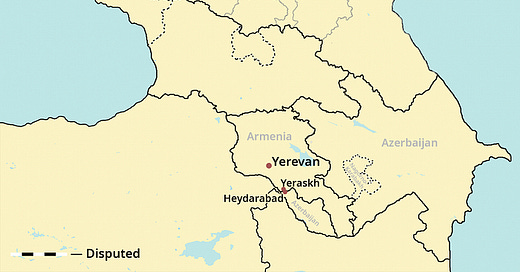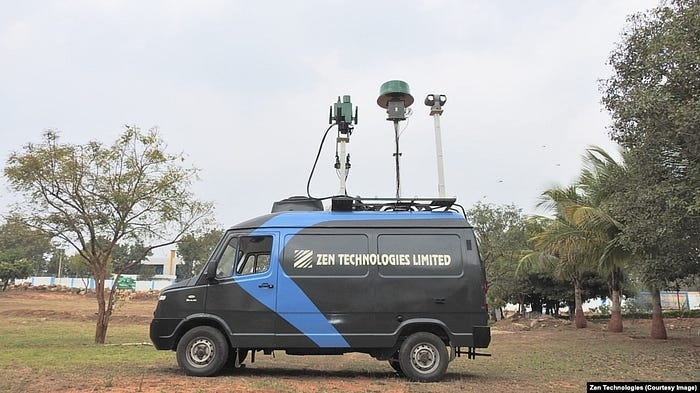The Geopolitical Implications of Indian Arms Sales to Armenia
And why this is a unique opportunity for Indian Armaments Manufacturers
Introduction:
Over the past 5 years, Indian Arms Manufacturers have signed several military deals with Armenia. This move by Armenia towards Indian armaments marks a shift in two important things. 1. the foreign policy goals of Armenia and 2. Indian strategic interests in the Caucasus, and the world at large.
Backdrop:
Armenia is a small country located in the South Caucasus. It Shares borders with Georgia to its North, Türkiye to its West, Iran to its South, the Azerbaijani Mainland in its East, and the Nakhchivan exclave of Azerbaijan in its Southwest.
Azerbaijan is an ethnically Turkic nation also in the South Caucasus. It borders with Iran to the South, Russia to the North, and also a short border with Türkiye through the Nakhchivan Exclave.
Azerbaijan and Türkiye are Armenia’s main adversaries due to historical reasons, namely the Armenian Genocide that took place under the Ottoman Empire in 1915–1916 which Türkiye denies.
Nagorno Karabakh, also known as Artsakh by Armenia (the two terms will be used interchangeably), is a territory that is legally a part of Azerbaijan but was populated by ethnic Armenians until very recently. It was a de-facto independent state. Although the majority population of the region was ethnically Armenian, it was placed in the Azerbaijani SSR as the Nagorno Karabakh Autonomous Oblast by the USSR. Armenia and Azerbaijan had fought two wars over the disputed region in 1994 and 2020.
Armenia won the first war and took control of Karabakh, its surrounding districts, and compelled the ethnic Azeri population to flee. Azerbaijan is rich in oil and natural gas. It used its oil and gas revenues to build up its military potential over several years, which it used to attack Artsakh in September 2020. Having won the second war, a ceasefire was negotiated with the condition that Armenia would open up unimpeded overland transportation access (colloquially known as the Zangezur Corridor) between the Azeri exclave of Nakhchivan and the Azeri mainland. It would also grant a direct land connection between Azerbaijan and its important ally Turkiye. This land connection would fuel Ankara’s ambitions for uniting the Turkic world. In return, the Lachin Corridor would be kept open between Artsakh and Armenia, whose security would be guaranteed by Russian Peacekeeping Forces.
The Blockade of Artsakh in 2022 and the Offensive of 2023:
In 2022, Azerbaijan blockaded the Lachin Corridor between Armenia and Artsakh with Russian forces refusing to intervene. It then launched an Offensive in September 2023 to take complete control of Nagorno Karabakh. There were also attacks on Armenia proper, marking a new level of escalation by Azerbaijan. The offensive prompted an exodus of almost all ethnic Armenians in Karabakh. This also endangers Armenian churches and monasteries in Karabakh.
Members of the CSTO were obliged to send troops to protect Armenia after it was attacked under Article 4 of the CSTO. However, Russia and other members refused military assistance to Armenia.
The refusal of Russia to intervene militarily in both 2020 and 2023, has led to a realignment by Armenia in its security strategy.
Armenia perceived this offensive as Azerbaijan having reneged on the 2020 Peace Agreement, leaving them with no reason to open the Zangezur Corridor. It also fears an infringement of its sovereignty by Azerbaijan as a pressure tactic to force the corridor open.
It is in this backdrop that we need to see the Arms deals between India and Armenia.
A History of Armenia and Azerbaijan’s Arms Suppliers:
Since the fall of the USSR, Armenia has purchased a vast majority of its weaponry (about 94%) mostly from Russia. Azerbaijan too has had a very large share of Russian Weapons (~60%), but has managed to diversify its suppliers, with Israel and Turkiye being major players in the market. It has also purchased equipment in a bunch of different fields, like drones, aircraft, artillery, and MLRS. This improves its combat readiness. However, as mentioned earlier, because of the war, and a lack of support from the CSTO, Armenia has been compelled to rethink its security policy and diversify its armament suppliers.
The Arms Sales made to Armenia by Indian Manufacturers:
The following Arms deals were signed between Armenia and India since 2020.
A deal for the SWATHI Weapons Locating Radar, signed in 2020,
2. A deal for Pinaka multi-barrel rocket launchers (MBRL), anti-tank missiles, rockets and ammunition worth US $250 million in September 2022,
3. a total of 84 155mm Howitzer guns, divided between the ATAGS (Advanced Towed Artillery Gun System) and the MArg Self-propelled howitzer guns
4. A US$ 41 million deal for the Zen anti-drone system.
The Pakistan-Turkiye-Azerbaijan Trilateral Relationship:
Since its independence in 1947, Pakistan and Turkiye have enjoyed extremely warm relations based on historical and cultural ties. Turkiye supports Pakistan against India on the Kashmir conflict, having raised the issue in the UN Multiple times. Similarly, following the dissolution of the USSR, Azerbaijan and Turkiye have shared very close diplomatic, cultural, and people-to-people relations based on ethnic ties (Azeris are a Turkic people), with the phrase, “One Nation, Two States” being used by the citizens of both the countries to describe their closeness. Over the past 10 years, the three nations have developed a strong trilateral relation, co-operating on military and economic affairs. This is highlighted by the “Three Brothers” Military Exercises held in Azerbaijan in 2021. Azerbaijan has also strongly come out in favour of Pakistan on the Kashmir conflict. Pakistan is the only country that refuses to recognize Armenia as an independent sovereign nation.
This stance taken by Turkiye and Azerbaijan did not go unnoticed, and has prompted New Delhi to call upon Azerbaijan to withdraw its forces and not cause any further provocation. Pakistani involvement in Karabakh makes it an extension of the Kashmir conflict, as far as India is concerned. It has to demonstrate some geopolitical posturing.
The Rationale behind the Arms Sales:
While there is no way to know, India might not have been Armenia’s first choice of heavy weapons suppliers. None of these weapons systems have been combat-tested yet, making this a big gamble for the Armenian military. However, there are several reasons for Armenia and India to sign these deals, involving both regional and outside players.
Azerbaijan: Relations between India and Azerbaijan have been quite frosty, and hence India does not have anything to lose by supplying Azerbaijan’s adversary.
Israel: Israel and Azerbaijan share close economic ties, especially with regards to oil and weaponry. Azerbaijan is also a base for Israel to launch its activities against Iran, its greatest rival.
Iran: Iran and Armenia share strong historical and cultural links that date back thousands of years. Iran also has a vested interest in bogging Azerbaijan down due to its support for Israel, and under normal circumstances would have been Armenia’s main weapons supplier. However, both sides have compulsions that prevent this. Since the Russian Invasion of Ukraine in 2022, Iran has emerged as one of Russia’s largest trading partners, with Azerbaijan providing a crucial transportation link between the two. Iran also has a very large Azeri population (about 20-25%) within its frontiers primarily in the borderlands with Armenia and Azerbaijan. Iran cannot afford to alienate its Azeri Minority for this very reason. Armenia also has reservations about Iranian Weaponry due to concerns of sanctions from the West.
Russia: Under ordinary circumstances, the Kremlin would have deep objections to Armenia diversifying its military suppliers. However, with the invasion of Ukraine, Russia is not in a capacity to supply Armenia with armaments. Russia might have ceded influence, but it has ceded influence to India, an ostensibly friendly nation, rather than NATO or its Allies, which it considers hostile powers. This also keeps the Russians relatively happy with Armenia.
Turkiye: Being a major arms supplier to Azerbaijan, it is quite obvious why the Turks will not supply Armenia with weapons.
NATO: NATO countries, especially European NATO members have been trying to diversify their Energy supplies away from Russia after 2022 and Azerbaijan has emerged as a crucial supplier for the same. European NATO members cannot afford to alienate Azerbaijan for this simple reason, and would be skeptical of supplying Armenia with heavy weaponry. At the same time, they are also happy to see Russia lose one small but significant customer of its military-industrial complex. Ideally, NATO would have loved to bag these contracts but it is more important for NATO to see Russian influence wane.
China: The People’s Republic of China would be interested in selling weaponry to Armenia. However, buying Chinese would alienate NATO from Armenia, making this a no-go.
India: Azeri involvement in the Kashmir conflict means India has no option but to push back. Supplying Azerbaijan’s main rival with weapons is the most surefire way of doing so. Armenia also provides a platform for India to showcase its weapons internationally. It is a major strategic win for India, which has been trying to bolster indigenous defence manufacturing. The SWATHI radar and Zen anti-drone system are local high-tech solutions which are a reminder of India’s growing prowess with respect to indigenous defense manufacturing. If India plays its cards right, it could cement its foothold in the Global Arms Market.
All of these factors come together to make India a consensus candidate for all the parties involved. It also grants India a new opportunity to make inroads into the Global Arms Market, which it has been trying to break into for years. If Indian hardware proves itself with Armenia’s Military, it opens the market up for several countries in Asia, South America, and Africa. India did make sales of the ALH Dhruv to Ecuador, but those helicopters were returned after a few years. This left a negative impression on India’s reputation, and this is a chance to reverse this. Indian companies must proactively supply Armenia with necessary technical assistance and spare parts, which was a field where HAL was lacking with regards to Ecuador.








